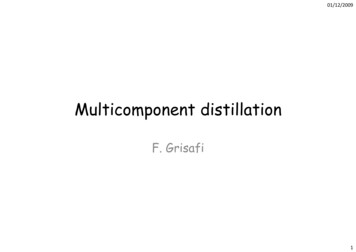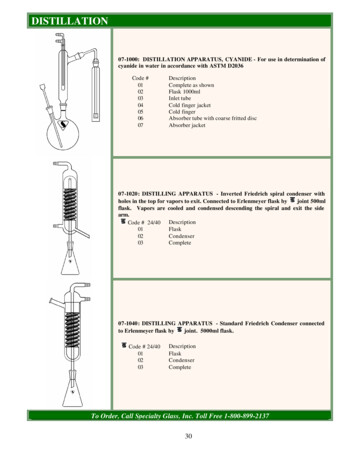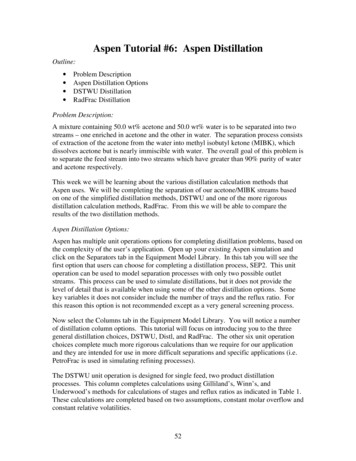
Transcription
01/12/2009Multicomponent distillationF. Grisafi1
01/12/2009IntroductionThe problem of determining the stage and refluxrequirementsit forf multicomponentltit distillationsdi till tiiis muchh morecomplex than for binary mixtures.pmixture, fixingg one componentpWith a multicomponentcomposition doesdnot uniquelylddeterminethehotherhcomponent compositions and the stage temperature.Also when the feed contacontainsns more than two components itt issnot possible to specify the complete composition of the topand bottom products independently.The separation between the top and bottom products isusually specified by setting limits on two "key components",between which it is desired to make the separation.2
01/12/2009Calculation procedureThe normal procedure for a typical problem is to solve the MESH(Material balance, Equilibrium, Summation and Heat) balanceequations stage-by-stage, from the top and bottom of the columntoward the feed point.For such a calculation to be exact, the compositions obtained fromboth the bottom-up and top-down calculations must mesh at thefeed point and mesh the feed composition.The calculated compositions will depend on the compositionsassumed for the top and bottom products at the commencement ofthe calculations.ThoughThh iti isi possibleibl to matchh theh keykcomponents, theh otherhcomponents will not match unless the designer was particularlyfortunate in choosing the trial top and bottom compositions.3
01/12/2009Calculation procedureFor a completelypy rigorous solution the compositionspmust beadjusted and the calculations repeated until a satisfactory matchat the feed point is obtained by iterative trial-and-errorcalculations.Clearly, the greater the number of components, the more difficultthe problem.For other than ideal mixtures,mixtures the calculations will be furthercomplicated by the fact that the component volatilities will befunctions of the unknown stage compositions.Iff more thanh a fewfstages are required,d stage-by-stagebcalculations are complex and tedious.4
01/12/2009“Short-cut"Short cut methodsBefore the advent of the modern digital computer,pvarious "shortcut" methods were developed to simplify the task of designingmulticomponent columns.Though computer programs will normally be available for therigorous solution of the MESH equations, short-cut methods arestill useful in the preliminary design work, and as an aid in definingproblems for computer solution.Intelligent use of the short-cut methods can reduce the computertime and costs.5
01/12/2009“Short-cut"Short cut methodsThe short-cut methods available can be divided into two classes:1. Simplifications of the rigorous stage-by-stage procedures toenable the calculations to be done using hand calculators, org pgraphically.yTypical examples of this approach are the methods given byHengstebeck (1961), and the Smith-Brinkley method (1960); whichare described in Section 11.7 (C&R Vol. VI).2. Empirical methods, which are based on the performance ofoperating columns, or the results of rigorous designs.ypexamplespof these methods are Gilliland's correlation,,Typicalwhich is given in (C&R Vol. II, Chapter 11) and the Erbar-Maddoxcorrelation given in Section 11.7.3 (C&R Vol. VI).6
01/12/2009“Key“Key componentsThe designer must select the two "key“ components between which it isdesired to make the separation.The light key will be the component that it is desired to keep out of thebottom product, and the heavy key the component to be kept out of thetop product.Specifications will be set on the maximum concentrations of the keys inthe top and bottom products.productsThe keys are known as "adjacent keys" if they are "adjacent" in a listing ofthe components in order of volatility, and "split keys" if some othercomponentplies between them in the order; theyy will usuallyy be adjacent.jIf any uncertainty exists in identifying keys components (e.g. isomers),trial calculations should be made using different components as the keys todetermine the pair that requires the largest number of stages forseparationp((the wworst case).).The "non-key" components that appear in both top and bottom productsare known as "distributed" components; and those that are not present, toany significant extent, in one or other product, are known as "nondistributed" components.distributedcomponents7
01/12/2009Number and sequencing of columnsIn multicomponent distillations it is not possible to obtain more than onepure component,component one sharp separation,separation in a single column.columnIf a multicomponent feed is to be split into two or more virtually pureproducts, several columns will be needed.Impure products can be taken off as side streams; and the removal of aside stream from a stage where a minor component is concentrated willreduce the concentration of that component in the main product.For separation of N components, with one essentially pure component takenoverhead or from the bottom of each column,overhead,column (N — 1) columns will beneeded to obtain complete separation of all components.For example, to separate a mixture of benzene, toluene and xylene twocolumns are needed (3-1), Benzene is taken overhead from the first columnand the bottom product, essentially free of benzene, is fed to the secondcolumn.This column separates the toluene and xylene.8
01/12/2009Costs considerationsThe order in which the componentspare separatedpwill determinethe capital and operating costs.Where there are several components the number of possiblesequences can be very large; for example,example with five components thenumber is 14, whereas with ten components it is near 5000.When designing systems that require the separation of severalcomponents efficient procedures are needed to determine thecomponents,optimum sequence of separation.Separation schemesfor a 4 componentsfmixture9
01/12/2009Heuristic rules for optimum sequencing1. Remove the components one at a time.2. Remove any components that are present in largeexcess early in the sequence.3. With difficult separations, involving close boilingcomponents, postpone the most difficult separation tolate in the sequence.Difficult separations will require many stages, so toreduce cost, the column diameter should be made asmall as posspossible.ble. As the column ddiameterameter iss dependenton flow-rate, the further down the sequence the smallerwill be the amount of material that the column has tohandle.10
01/12/2009Tall and vacuum columnsWhere a largeg number off stagesg is required,q, it mayy benecessary to split a column into two or more separatecolumns to reduce the height of the column, eventhough the required separation could,could theoretically,theoreticallyhave been obtained in a single column.This may also be done in vacuum distillations, to reducethe column pressure drop and limit the bottomtemperatures.temperatures11
01/12/2009Short-cutsShortcuts methods12
01/12/2009Short-cut methods for stage and refluxrequirementsitSome of the more useful short-cut pprocedures whichcan be used to estimate stage and reflux requirementswithout the aid of computers are given in this section.Mostt ofMf theth short-cuth t t methodsth d were developeddld forf thethdesign of separation columns for hydrocarbon systemsin the petroleum and petrochemical systems industries,andd cautiontimustt beb exercisedi d whenhapplyingl iththemttoother systems (as it is assumed almost ideal behavior ofmixtures).They usually depend on the assumption of constantrelative volatility, and should not be used for severelynon ideal systems.non-ideal13
01/12/2009Pseudo-binaryPseudobinary systemsIf the presence of the other components does not significantlyaffect the volatility of the key components,components the keys can betreated as a pseudo-binary pair.The number of stages can then be calculated using a McCabeThiele diagram,diagram or the other methods developed for binarysystems.This simplification can often be made when the amount of the nonkey components is small,small or where the components form near-idealmixtures.Where the concentration of the non-keys is small, say less than10% they can be lumped in with the key components.10%,componentsFor higher concentrations the method proposed by Hengstebeck(1946) can be used to reduce the system to an equivalent binarysystem.system14
01/12/2009Hengstebeck'ss methodHengstebeckFor any component i the Lewis-Sorel material balanceequationsqand equilibriumqrelationshipp can be written interms of the individual component molar flow rates; inplace of the component composition:Rectifying sectionStripping section15
01/12/2009Hengstebeck'ss methodHengstebeckTo reduce a multicomponentpsystemyto an equivalentqbinary it is necessary to estimate the flow-rate of thekey components throughout the column.Hengstebeck considers that in a typical distillation theflow-rates of each of the light non-key componentsapproaches a constant,constant limiting,limiting rate in the rectifyingsection; and the flows of each of the heavy non-keycomponents approach limiting flow-rates in the strippingsection.ti16
01/12/2009Hengstebeck'ss methodHengstebeckPutting the flow-rates of the non-keys equal to theseli itilimitingratesti eachinh sectiontienablesblth combinedthebi dflows of the key components to be estimated.lighterspeciesRectifying sectionStripping sectionhheavieri speciesi17
01/12/2009Hengstebeck'ss methodHengstebeckThe method used to estimate the limiting flow-rates isth t proposedthatd byb JennyJ(1939) Th(1939).The equationstiare:Rectifying sectionStripping sectiondi and bi corresponding top and bottom flow rate of component i.18
01/12/2009Hengstebeck'ss methodHengstebeckEstimates of the flows of the combined keys enable operating lines to bedrawn for the equivalent binary system.systemThe equilibrium line is drawn by assuming a constant relative volatility forthe light key:where y and x refer to the vapor and liquid concentrations of the light key.Hengstebeck shows how the method can be extended to deal withsituationsit tiwherehth relativethel tivolatilityl tilit cannott beb takent kas constant,t t anddhow to allow for variations in the liquid and vapor molar flow rates.He also ggives a more rigorousggraphicalgpprocedure based on the LewispMatheson method (see Section 11.8).19
01/12/2009Bubble and Dew Point calculationsKi F(T)c[De Priester charts]Bubble point temperature (xi known): K (T ) xii 1i 1 cf (T ) K i (T ) xi 1i 1Dew point temperature (yi known):c i 1yiK i (T ) 1 cf (T ) i 1yiK i (T ) 1Solution: find the temperature T by trial-and-error procedure as f(T) 020
01/12/2009Example 11.5Estimate the number of ideal stages needed in the butane-pentanesplitter defined by the compositions given in the table below.The column will operate at a pressure of 8.38 3 bar,bar with a reflux ratioR 2.5. The feed is at its boiling point (q 1).Assumed composition(for DP & BP calculations)xdxbC30.1110.000iC40 3330.3330 e: a similar problem has been solved by Lyster et al.al (1959) using arigorous computer method and it was found that 10 stages were needed.21
01/12/2009Example 11.5 - solutionThe top and bottom temperatures (dew points and bubble points)were calculated by the methods illustrated in Example 11.9.Relative volatilities are given by equation 8.30:Equilibrium constants were taken from the De Priester charts.Relative volatilities estimated:LightLiht non-keyk comp.Light non-key comp.Heavy non-key comp.22
01/12/2009Example 11.5 - solutionRectifying sectionStripping sectionCalculations ofnon-key flows:StrippingsectionRectifyingsection23
01/12/2009Example 11.5 - solutionFlow of combined keys:RRectifyingif i sectioniS i i sectionStrippingiL RDV (R 1)DV’ V-(1-q)FL L qFL’ L qFR reflux ratio; q feed thermal index (1 for boiling liquid; 0 for saturated vapour)24
01/12/2009Example 11.5 - solutionEquilibrium curveEquilibrium points25
01/12/2009Example 11.5 - solutionThe McCabe-Thiele diagramgis shown in Figure:g12 stagesg required;qfeed on seventh from base.26
01/12/2009Empirical correlations methodsThe two most frequentlyqy used empiricalpmethods for estimatingg thestage requirements for multicomponent distillations are thecorrelations published by Gilliland (1940) and by Erbar and Maddox(1961).These relate the number of ideal stages required for a givenseparation, at a given reflux ratio, to the number at total reflux((minimum ppossible)) and the minimum reflux ratio ((infinite numberof stages).Gilliland's correlation is given in C-R Vol. 2, Chapter 11.The Erbar-Maddox correlation is given in this section, as it is nowgenerally considered to give more reliable predictions.Theirhe r correlatcorrelationon iss shown inn FFiguregure 11.11;. ; whwhichch ggivesves the ratratioo ofnumber of stages required to the number at total reflux, as afunction of the reflux ratio, with the minimum reflux ratio as apparameter.To use Figure 11.11, estimates of the number of stages at totalreflux and the minimum reflux ratio are needed.27
01/12/2009Number of stages calculationFig.11.11Erbar MaddoxErbar-Maddoxcorrelation(1961)R/(R 1) 0.6Example:Rm 1.33R 1.5Rm/(Rm 1) 0.57R/(R 1) 0.6Nm/N 0.34/N 0 34Nm/N 0.3428
01/12/2009Number of stages calculationGilliland correlation (1940), C&R II Vol.Log-log plotLinear plot 1 54 .4 Ψ Ψ 1 n nm 1 exp 0 .5 n 111 117.2Ψ Ψ where:Ψ R RmR 129
01/12/2009MinimumMn mum numbernum r of stagstagess (Fenske(F ns EquatEquation)on)The Fenske equation (Fenske, 1932) can be used to estimate theminimum stages required at total reflux.The derivation of this equation for a binary system is given in C-RC RVol. 2, Chapter 11. The equation applies equally to multicomponentsystems and can be written as:30
01/12/2009MinimumMn mum numbernum r of stagstagess (Fenske(F ns EquatEquation)on)Normally the separation required will be
Calculation procedure The normal procedure for a typical problem is to solve the MESH (Material balance, Equilibrium, Summation and Heat) balance equations stage-by-stage, from the top and bottom of the column toward the feed point. For such a calculation to be exact, the compositions obtained from both the bottom-up and top-down calculations must mesh at the feed point and mesh the feed .











